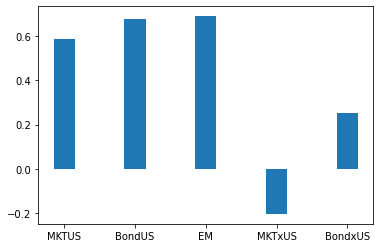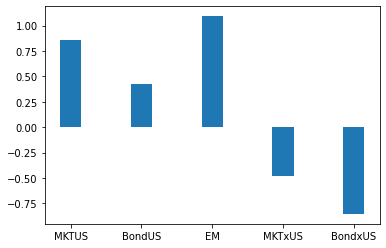Portfolio Optimization with constraints
import pandas as pd
import numpy as np
import matplotlib.pyplot as plt
%matplotlib inline
#GlobalFinMonthly
url="https://raw.githubusercontent.com/amoreira2/Lectures/4b95c7d60e869dffa6367c1730183b68920ed2b9/assets/data/GlobalFinMonthly.csv"
Data = pd.read_csv(url,na_values=-99)
# tell python Date is date:
Data['Date']=pd.to_datetime(Data['Date'])
# set an an index
Data=Data.set_index(['Date'])
Data=Data.rename(columns={Data.columns[1]: "MKTUS",Data.columns[2]: "BondUS",
Data.columns[3]: "EM",Data.columns[4]: "MKTxUS",Data.columns[5]: "BondxUS" })
df=(Data.drop('RF',axis=1)).subtract(Data['RF'],axis='index')
df.tail()
| MKTUS | BondUS | EM | MKTxUS | BondxUS | |
|---|---|---|---|---|---|
| Date | |||||
| 2016-08-31 | 0.0050 | -0.008617 | 0.024986 | 0.000638 | -0.009752 |
| 2016-09-30 | 0.0025 | -0.016617 | 0.012953 | 0.012536 | 0.009779 |
| 2016-10-31 | -0.0202 | -0.049660 | 0.002274 | -0.020583 | -0.043676 |
| 2016-11-30 | 0.0486 | -0.081736 | -0.046071 | -0.019898 | -0.050459 |
| 2016-12-31 | 0.0182 | -0.005596 | 0.002604 | 0.034083 | -0.023507 |
9.4. Portfolio Optimization with constraints#
Another practical issue that practioners face is that MV analysis (in it’s more pure form) does not account for several real world frictions that are more or less important depending on the investor:
Shorting an asset requires paying a borrowing fee to the owner of the asset. Shorting costs are sometimes prohibitive for small illiquid stocks
Most investors cannot really borrow at anything close to the risk-free rate–i.e., often they have to pay a substantially higher rate to borrow than to lend.
Python has the flexibility to solve the mean-variance problem numerically
Allows you to impose realistic features to our portfolio problem
Shorting costs
Borrowing costs higher than lending costs
Leverage constraints
Position limits due to investment mandates
Lets start by importing optimization package – think of a much more powerful solver (excel)
from scipy.optimize import minimize
we will now learn how to do a numerical minimization.
start by defining some useful variables
ERe=Re.mean()
print(ERe)
Cove=Re.cov()
print(Cove)
MKTUS 0.005140
BondUS 0.002523
EM 0.006923
MKTxUS 0.004149
BondxUS 0.002054
dtype: float64
MKTUS BondUS EM MKTxUS BondxUS
MKTUS 0.001948 0.000111 0.001292 0.001264 0.000187
BondUS 0.000111 0.001227 -0.000204 -0.000013 0.000264
EM 0.001292 -0.000204 0.003556 0.001661 0.000249
MKTxUS 0.001264 -0.000013 0.001661 0.002182 0.000422
BondxUS 0.000187 0.000264 0.000249 0.000422 0.000407
Modeling Borrowing limits
# the risk-free rate is special because at a given time we know exactly what the expected returns of investing
# in it, since it is risk-free!
# so it does not make sense to use the average risk-free rate in the portfolio problem, and we should rather use the one that
# we currently can invest at no risk
# here we are dividing by 12 becasue we are using annualized numbers
rf=0.01/12
print(rf)
# below is the target for monthly expected returns
Ertarget=0.06/12
print(Ertarget)
# We pick a margin requirement
margin=0.5
0.0008333333333333334
0.005
The program will choose a vector of weights that minimzies some function (of the chosen weights) subject to some constraint
we need to provide an initial condition for these weights, which essentially tells python the shape of the variable that it is choosing. Here we will start with a equal weighted portfolio
When solving minimization problems it is important to check that the exact initial conditions that you put in don’t matter.
I mean, it’s shape obviously matter, but whether is equal weighted or any other weighting scheme, the minimization should end up in the same place otherwise the numerical is not converging and you need to adjust the stop conditions
We refer to this as making sure that you are finding a “global optimum” and not a “local optimum”
n=Re.shape[1]
W0=np.ones(n)/n
W0
array([0.2, 0.2, 0.2, 0.2, 0.2])
The objective function
We need to specify the function that our minimizer will try to minimize,i.e, our objective
obviously this should be written as a function of the portfolio weights
In this case it is the variance of a portfolio with weights W
the weights will be our choice variable
The minimization function will change the weights until this variance is minimized
# STEP 1: define the objective function, which is the variance of the portfolio in our case
def func(W,Cove=Re.cov()):
return W @ Cove @ W
Finally we need to specify the set of constraints that the minimization problem must satisfy
you can specify two types of constraints: Equalities and inequalities.
Equalities:
specified as ‘eq’
For example:
{'eq', 'fun' : lambda W : W.T @ (ERe+rf) +(1-W.sum())*rf-target}defines the function
F(W)=W @ (ERe+rf) +(1-W.sum())*rf-targetand requires W to satisfy F(W)=0, i.e.,
W @ (ERe+rf) +(1-W.sum())*rf=target, or
\[W'(ERe+rf) +(1-\sum w_i)rf=target\]“target” here is the target for expected returns
Inequalities:
specified as ‘ineq’
For example:
{'ineq', 'fun' : lambda W: -W.sum()+1/margin}Defines
F(W)=-W.sum()+1/marginand requires F(W)>=0, i.e.,
\[\frac{1}{margin}\geq W.sum()\]
It is useful to create a function that returns the expected returns of our portfolio given a weight choice
def expected_return(W):
return W @ (ERe+rf) +(1-W.sum())*rf
# STEP 2: define constraint functions, we have two constraints: (1) target average return, and (2) leverage limit
Ertarget=0.12/12
cons=({'type': 'eq',
'fun' : lambda W : expected_return(W)-Ertarget},
{'type': 'ineq',
'fun' : lambda W: -W.sum()+1/margin})
cons
({'type': 'eq', 'fun': <function __main__.<lambda>(W)>},
{'type': 'ineq', 'fun': <function __main__.<lambda>(W)>})
Finally we are ready to do our minimization
options={'disp': True}: tell python to report intermediary steps so we can check if the algorithm is doing progress towards a solution.There is a variety of additional parameters that you can pass to the minimizer.
see: https://docs.scipy.org/doc/scipy/reference/generated/scipy.optimize.minimize.html
# STEP 3: solve the minimization problem with constraints and save as `sol`
sol = minimize(lambda x: func(x,Cove=Re.cov()),W0, constraints=cons, options={'disp': True})
Optimization terminated successfully (Exit mode 0)
Current function value: 0.003404665865183952
Iterations: 7
Function evaluations: 42
Gradient evaluations: 7
sol.x.sum()
2.0
# STEP 4: get the optimal portfolio weights
sol.x
array([ 0.58565363, 0.67667759, 0.69052641, -0.20448374, 0.25162612])
Solution is saved in sol
Lets plot the optimal weights
# below I am plotting the solution weights.
width=0.3
ind=np.arange(Re.shape[1])
fig, ax = plt.subplots()
ax.bar(ind,sol.x,width)
# ax.set_xticks(np.array([0,1,2,3,4,5])+ width / 2)
ax.set_xticks(ind)
ax.set_xticklabels(Re.columns)
plt.show()

lets now introduce the realistic feature that you have to pya a spread to borrow on margin
all we need to do is to change our expected return function
And we need to redefine the constraints to they re updated
I am setting a spread of 2%
def expected_return(W,spread):
return W @ (ERe+rf) +(1-W.sum())*rf+ min(0,1-W.sum())*spread
def constraint(target,spread):
cons=({'type': 'eq',
'fun' : lambda W : expected_return(W,spread)-target},
{'type': 'ineq',
'fun' : lambda W: -W.sum()+1/margin})
return cons
Ertarget=0.12/12
spread=0.02/12
sol = minimize(lambda x: func(x,Cove=Re.cov()),W0, constraints=constraint(Ertarget,spread), options={'disp': True})
width=0.3
ind=np.arange(Re.shape[1])
fig, ax = plt.subplots()
ax.bar(ind,sol.x,width)
# ax.set_xticks(np.array([0,1,2,3,4,5])+ width / 2)
ax.set_xticks(ind)
ax.set_xticklabels(Re.columns)
plt.show()
Optimization terminated successfully (Exit mode 0)
Current function value: 0.005671948276218396
Iterations: 17
Function evaluations: 119
Gradient evaluations: 17

What do you think will happen with the sum of weights as the spread increases?
Suppose you increase this spread quite a bit, will a reduction in margin impact the optimal choice?
When the margin is more likely to bind for an investor?
Shorting
Lets now model shorting constraints
We will mode shorting fees which can be scalar or a vector for each asset, we label this
sfThe shorting fee will be charge to any negative postion, hence
min(0,W)which has value zero if the weight is positiveWe will also change the margin constraint to account for shorting margin by simply using the absolute value of your positions
margin=0.5
def expected_return(W,spread,sf):
return W @ (ERe+rf) +(1-W.sum())*rf+ min(0,1-W.sum())*spread+(sf*np.minimum(0,W)).sum()
def constraint(target,spread,sf):
cons=({'type': 'eq',
'fun' : lambda W : expected_return(W,spread,sf)-target},
{'type': 'ineq',
'fun' : lambda W: -np.abs(W).sum()+1/margin})
return cons
To focus on the role of shortign constraints let me start with the case of zero spread and lending fee
Ertarget=0.12/12
spread=0.0/12
sf=0
sol = minimize(lambda x: func(x,Cove=Re.cov()),W0, constraints=constraint(Ertarget,spread,sf), options={'disp': True})
width=0.3
ind=np.arange(Re.shape[1])
fig, ax = plt.subplots()
ax.bar(ind,sol.x,width)
# ax.set_xticks(np.array([0,1,2,3,4,5])+ width / 2)
ax.set_xticks(ind)
ax.set_xticklabels(Re.columns)
plt.show()
Optimization terminated successfully (Exit mode 0)
Current function value: 0.0033237802440886253
Iterations: 7
Function evaluations: 42
Gradient evaluations: 7

You can do a multitude of different problems by making small changes to this code:
Borrowing at the risk-free rate is not allowed, but lending is allowed
Shorting of any asset is not allowed
Shorting of some assets are not allowed
Shorting has an extra cost
Leverage is allowed, but borrowing rate is higher than risk-free rate
How would you implement a hard shorting constraint?
How would you implement no shorting of bonds, but allow investor to short equity markets (which can be done using futures)?


